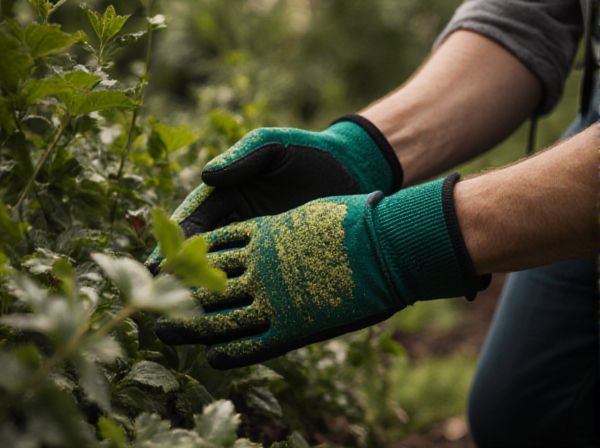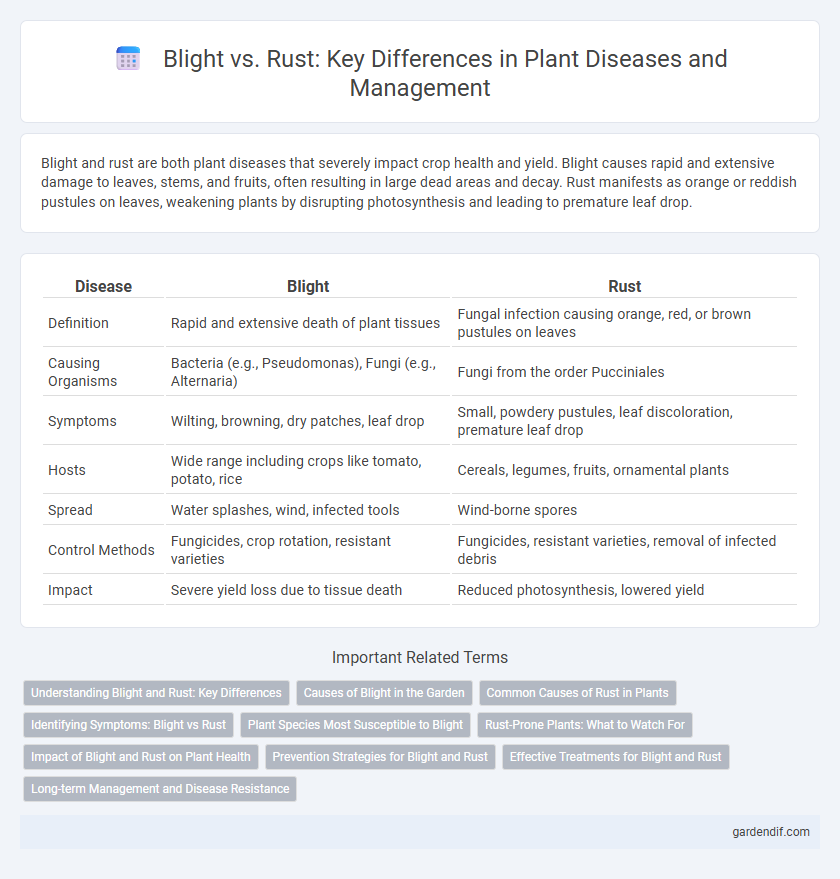
Blight vs Rust Illustration
Blight and rust are both plant diseases that severely impact crop health and yield. Blight causes rapid and extensive damage to leaves, stems, and fruits, often resulting in large dead areas and decay. Rust manifests as orange or reddish pustules on leaves, weakening plants by disrupting photosynthesis and leading to premature leaf drop.
Table of Comparison
| Disease | Blight | Rust |
|---|---|---|
| Definition | Rapid and extensive death of plant tissues | Fungal infection causing orange, red, or brown pustules on leaves |
| Causing Organisms | Bacteria (e.g., Pseudomonas), Fungi (e.g., Alternaria) | Fungi from the order Pucciniales |
| Symptoms | Wilting, browning, dry patches, leaf drop | Small, powdery pustules, leaf discoloration, premature leaf drop |
| Hosts | Wide range including crops like tomato, potato, rice | Cereals, legumes, fruits, ornamental plants |
| Spread | Water splashes, wind, infected tools | Wind-borne spores |
| Control Methods | Fungicides, crop rotation, resistant varieties | Fungicides, resistant varieties, removal of infected debris |
| Impact | Severe yield loss due to tissue death | Reduced photosynthesis, lowered yield |
Understanding Blight and Rust: Key Differences
Blight and rust are distinct plant diseases caused by different pathogens, with blight typically resulting from fungal or bacterial infections leading to rapid tissue death and rust arising from specialized fungal species producing characteristic orange or reddish pustules on leaves. Blight affects multiple parts of the plant, including leaves, stems, and fruits, causing extensive decay, whereas rust primarily targets foliage, reducing photosynthetic capacity and weakening overall plant health. Understanding these differences in pathogen type, symptoms, and affected plant areas is crucial for effective diagnosis and targeted disease management in agriculture.
Causes of Blight in the Garden
Blight in the garden is primarily caused by fungal pathogens such as Alternaria, Phytophthora, and Botrytis species that thrive in wet, humid conditions. Poor air circulation, overwatering, and contaminated soil or plant debris increase the likelihood of infection by creating an ideal environment for spore germination and rapid disease spread. Unlike rust, which specifically targets plant tissues causing pustules, blight leads to widespread tissue death, manifesting as dark lesions and rapid collapse of leaves and stems.
Common Causes of Rust in Plants
Rust in plants commonly arises from fungal pathogens in the Pucciniales order, thriving in moist, humid environments that facilitate spore germination and infection. Poor air circulation, excessive nitrogen fertilization, and proximity to infected plants significantly increase the risk of rust development. Species such as Puccinia graminis and Uromyces appendiculatus are primary rust agents affecting cereal crops and legumes, respectively, leading to compromised photosynthesis and reduced yield.
Identifying Symptoms: Blight vs Rust
Blight presents as large, irregular brown or black lesions that rapidly cause tissue death on leaves, stems, or fruits, often accompanied by wilting and defoliation. Rust is characterized by small, powdery pustules that produce orange, yellow, or reddish spores, primarily on the undersides of leaves, leading to premature leaf drop. Accurate identification hinges on observing lesion size, color, and spore presence, distinguishing blight's rapid necrosis from rust's distinctive pustule formation.
Plant Species Most Susceptible to Blight
Tomato, potato, and citrus plants are the most susceptible to blight, with early blight and late blight commonly affecting tomatoes and potatoes, causing significant crop losses. Citrus blight primarily targets citrus species like oranges, grapefruits, and lemons, leading to fruit drop and tree decline. These plant species exhibit heightened vulnerability to blight pathogens such as Phytophthora infestans and Alternaria solani, which thrive under moist, warm conditions.
Rust-Prone Plants: What to Watch For
Rust primarily targets plants such as wheat, barley, and beans, causing orange to reddish pustules on leaves and stems that reduce photosynthesis and crop yield. Common rust symptoms include small, powdery spores that spread rapidly under moist, warm conditions, making early detection and proper monitoring crucial. Understanding the susceptibility of specific crops to rust fungi aids in implementing timely fungicide treatments and resistant plant varieties.
Impact of Blight and Rust on Plant Health
Blight causes rapid and extensive damage to plant tissues, leading to leaf wilting, stem discoloration, and fruit rot, severely reducing crop yield and quality. Rust manifests as orange or reddish pustules on leaves and stems, disrupting photosynthesis and weakening plant vigor, which compromises overall growth. Both diseases significantly impair plant health by reducing photosynthetic efficiency and increasing susceptibility to secondary infections.
Prevention Strategies for Blight and Rust
Preventing blight involves crop rotation, resistant plant varieties, and timely fungicide applications to limit the spread of airborne spores. Rust control emphasizes using resistant cultivars, maintaining proper plant spacing for airflow, and removing infected plant debris to reduce overwintering inoculum. Both diseases require vigilant monitoring and integrated disease management to minimize crop loss effectively.
Effective Treatments for Blight and Rust
Effective treatments for blight typically include the application of fungicides containing chlorothalonil, copper-based compounds, or mancozeb, which help inhibit fungal growth and prevent disease spread. For rust, sulfur-based fungicides and systemic treatments such as myclobutanil or propiconazole are commonly used to control rust spores and reduce lesions. Both diseases benefit from integrated pest management practices, including crop rotation, resistant plant varieties, and proper sanitation to minimize infection rates.
Long-term Management and Disease Resistance
Blight and rust diseases require distinct long-term management strategies to ensure crop health and yield stability. Integrating resistant cultivars that target specific pathogens plays a crucial role in minimizing damage from blight caused by bacterial or fungal pathogens, while rust resistance genes provide durable defense against various Puccinia species. Employing crop rotation, timely fungicide applications, and monitoring environmental conditions enhances resistance efficacy and reduces disease incidence over multiple growing seasons.
Blight vs Rust Infographic

 gardendif.com
gardendif.com